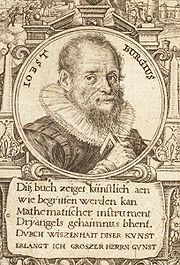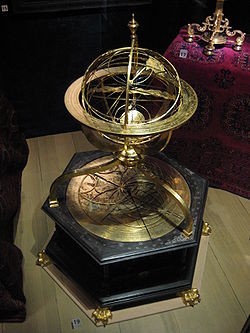
Joost Bürgi
Encyclopedia




Lichtensteig
Lichtensteig is a municipality in the Wahlkreis of Toggenburg in the canton of St. Gallen in Switzerland.-History:Lichtensteig is first mentioned in 1228 as Liehtvnsteige. In 1310 it was mentioned as Liechtensteig.-Geography:...
, Switzerland
Switzerland
Switzerland name of one of the Swiss cantons. ; ; ; or ), in its full name the Swiss Confederation , is a federal republic consisting of 26 cantons, with Bern as the seat of the federal authorities. The country is situated in Western Europe,Or Central Europe depending on the definition....
– January 31, 1632), active primarily at the courts in Kassel
Kassel
Kassel is a town located on the Fulda River in northern Hesse, Germany. It is the administrative seat of the Kassel Regierungsbezirk and the Kreis of the same name and has approximately 195,000 inhabitants.- History :...
and Prague
Prague
Prague is the capital and largest city of the Czech Republic. Situated in the north-west of the country on the Vltava river, the city is home to about 1.3 million people, while its metropolitan area is estimated to have a population of over 2.3 million...
, was a Swiss clockmaker
Clockmaker
A clockmaker is an artisan who makes and repairs clocks. Since almost all clocks are now factory-made, most modern clockmakers only repair clocks. Modern clockmakers may be employed by jewellers, antique shops, and places devoted strictly to repairing clocks and watches...
, a maker of astronomical instruments and a mathematician
Mathematics
Mathematics is the study of quantity, space, structure, and change. Mathematicians seek out patterns and formulate new conjectures. Mathematicians resolve the truth or falsity of conjectures by mathematical proofs, which are arguments sufficient to convince other mathematicians of their validity...
.
Life
Jost Bürgi is widely considered one of the most innovative and most skillful 'mechanics' of his era. It has been suggested that he should also be counted among the leading astronomerAstronomer
An astronomer is a scientist who studies celestial bodies such as planets, stars and galaxies.Historically, astronomy was more concerned with the classification and description of phenomena in the sky, while astrophysics attempted to explain these phenomena and the differences between them using...
s of his time because his unprecedented ability to design and construct mechanical models of the movement of heavenly bodies proves an advanced level of insight into celestial mechanics. His classification as a scholar is controversial because he lacked a formal education and did not know Latin
Latin
Latin is an Italic language originally spoken in Latium and Ancient Rome. It, along with most European languages, is a descendant of the ancient Proto-Indo-European language. Although it is considered a dead language, a number of scholars and members of the Christian clergy speak it fluently, and...
, the only language of scholarly publications at the time. Another autodidact, Nicolaus Reimers, in 1587 translated Copernicus' De Revolutionibus Orbium Coelestium
De revolutionibus orbium coelestium
De revolutionibus orbium coelestium is the seminal work on the heliocentric theory of the Renaissance astronomer Nicolaus Copernicus...
into German for Bürgi. A copy of the translation survived in Graz
Graz
The more recent population figures do not give the whole picture as only people with principal residence status are counted and people with secondary residence status are not. Most of the people with secondary residence status in Graz are students...
, it is thus called "Grazer Handschrift".
He left few written records of his work. However other historians of science
History of science
The history of science is the study of the historical development of human understandings of the natural world and the domains of the social sciences....
claim that Bürgi's legacy of many unique and innovative mechanical astronomical models
Model (physical)
A physical model is a smaller or larger physical copy of an object...
should be considered an unorthodox method of 'publishing' astronomical
Astronomy
Astronomy is a natural science that deals with the study of celestial objects and phenomena that originate outside the atmosphere of Earth...
insights. During his years in Praha he worked closely with the astronomer
Astronomer
An astronomer is a scientist who studies celestial bodies such as planets, stars and galaxies.Historically, astronomy was more concerned with the classification and description of phenomena in the sky, while astrophysics attempted to explain these phenomena and the differences between them using...
Johannes Kepler
Johannes Kepler
Johannes Kepler was a German mathematician, astronomer and astrologer. A key figure in the 17th century scientific revolution, he is best known for his eponymous laws of planetary motion, codified by later astronomers, based on his works Astronomia nova, Harmonices Mundi, and Epitome of Copernican...
at the court of Rudolf II.
Bürgi as a clockmaker
It is undocumented where he learned his clockmaking skills, but eventually he became the most innovative clock and scientific instrument maker of his time. Among his major horological inventions were the cross-beat escapement, and the remontoireRemontoire
In mechanical horology, a remontoire, is a small secondary source of power, a weight or spring, which runs the timekeeping mechanism and is itself periodically rewound by the timepiece's main power source, such as a mainspring...
, two mechanisms which improved the accuracy of mechanical clocks of the time by orders of magnitude. This allowed for the first time clocks to be used as scientific instruments, with enough accuracy to time the passing of stars (and other heavenly bodies) in the crosshairs of telescopes to start accurately charting stellar positions.
Working as an instrument maker for the court of William IV, Landgrave of Hesse-Kassel
William IV, Landgrave of Hesse-Kassel
William IV of Hesse-Kassel , also called William the Wise, was the first Landgrave of Hesse-Kassel . He was the founder of the oldest line, which survives to this day.-Life:...
in Kassel
Kassel
Kassel is a town located on the Fulda River in northern Hesse, Germany. It is the administrative seat of the Kassel Regierungsbezirk and the Kreis of the same name and has approximately 195,000 inhabitants.- History :...
he played a pivotal role in developing the first astronomical charts. He invented logarithms as a working tool for himself for his astronomical calculations, but as a "craftsman/scholar" rather than a "book scholar" he failed to publish his invention for a long time.
In 1592 Rudolf II, Holy Roman Emperor
Rudolf II, Holy Roman Emperor
Rudolf II was Holy Roman Emperor , King of Hungary and Croatia , King of Bohemia and Archduke of Austria...
in Prague
Prague
Prague is the capital and largest city of the Czech Republic. Situated in the north-west of the country on the Vltava river, the city is home to about 1.3 million people, while its metropolitan area is estimated to have a population of over 2.3 million...
received from his uncle, the Landgrave of Hesse-Kassel, a Bürgi globe and insisted that Bürgi deliver it personally. From then on Bürgi commuted between Kassel and Prague, and finally entered the service of the emperor in 1604 to work for the imperial astronomer Johannes Kepler
Johannes Kepler
Johannes Kepler was a German mathematician, astronomer and astrologer. A key figure in the 17th century scientific revolution, he is best known for his eponymous laws of planetary motion, codified by later astronomers, based on his works Astronomia nova, Harmonices Mundi, and Epitome of Copernican...
.
Works
The most significant artifacts designed and built by Burgi surviving in museums are:- Several mechanized celestial globes (now in Paris, Zuerich (Schweizerisches Landesmuseum), Stuttgart (Wurttembergisches Landesmuseum) and Kassel (Orangerie,2x,1580-1595) )
- Several clocks in Kassel, Dresden (Mathematisch Physikalischer Salon) and Vienna (Kunsthistorisches Museum)
- Sextants made for Kepler (at the National Technical Museum in Prag)
- The Mond-Anomalien-Uhr (a mechanical model of the irregularities of the motion of the Moon around the Earth)
Bürgi as a mathematician
He invented logarithmLogarithm
The logarithm of a number is the exponent by which another fixed value, the base, has to be raised to produce that number. For example, the logarithm of 1000 to base 10 is 3, because 1000 is 10 to the power 3: More generally, if x = by, then y is the logarithm of x to base b, and is written...
s independently of John Napier
John Napier
John Napier of Merchiston – also signed as Neper, Nepair – named Marvellous Merchiston, was a Scottish mathematician, physicist, astronomer & astrologer, and also the 8th Laird of Merchistoun. He was the son of Sir Archibald Napier of Merchiston. John Napier is most renowned as the discoverer...
, since his method is distinct from Napier's. Napier published his discovery in 1614, and this publication was widely disseminated in Europe by the time Bürgi published at the behest of Johannes Kepler
Johannes Kepler
Johannes Kepler was a German mathematician, astronomer and astrologer. A key figure in the 17th century scientific revolution, he is best known for his eponymous laws of planetary motion, codified by later astronomers, based on his works Astronomia nova, Harmonices Mundi, and Epitome of Copernican...
. There is evidence that Bürgi arrived at his invention as early as 1588, six years before Napier began work on the same idea. By delaying the publication of his work to 1620, Bürgi lost his claim for priority in historic discovery. Bürgi was also a major contributor to prosthaphaeresis
Prosthaphaeresis
Prosthaphaeresis was an algorithm used in the late 16th century and early 17th century for approximate multiplication and division using formulas from trigonometry. For the 25 years preceding the invention of the logarithm in 1614, it was the only known generally-applicable way of approximating...
, a technique for computing products quickly using trigonometric identities, which predated logarithms.
The lunar
Moon
The Moon is Earth's only known natural satellite,There are a number of near-Earth asteroids including 3753 Cruithne that are co-orbital with Earth: their orbits bring them close to Earth for periods of time but then alter in the long term . These are quasi-satellites and not true moons. For more...
crater
Impact crater
In the broadest sense, the term impact crater can be applied to any depression, natural or manmade, resulting from the high velocity impact of a projectile with a larger body...
Byrgius
Byrgius (crater)
Byrgius is a lunar crater located in the western part of the Moon, near the limb. As a result Byrgius appears strongly oval in form due to foreshortening. To the northwest is the nearly ruined crater Lamarck. The rim of Byrgius is worn and eroded, with Byrgius A overlying the eastern rim and...
is named in his honor.
External links
- http://www-history.mcs.st-andrews.ac.uk/Mathematicians/Burgi.html
Bürgi's Progress Tabulen (1620): logarithmic tables without logarithms * http://www.loria.fr/~roegel/locomat.html

